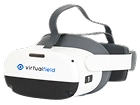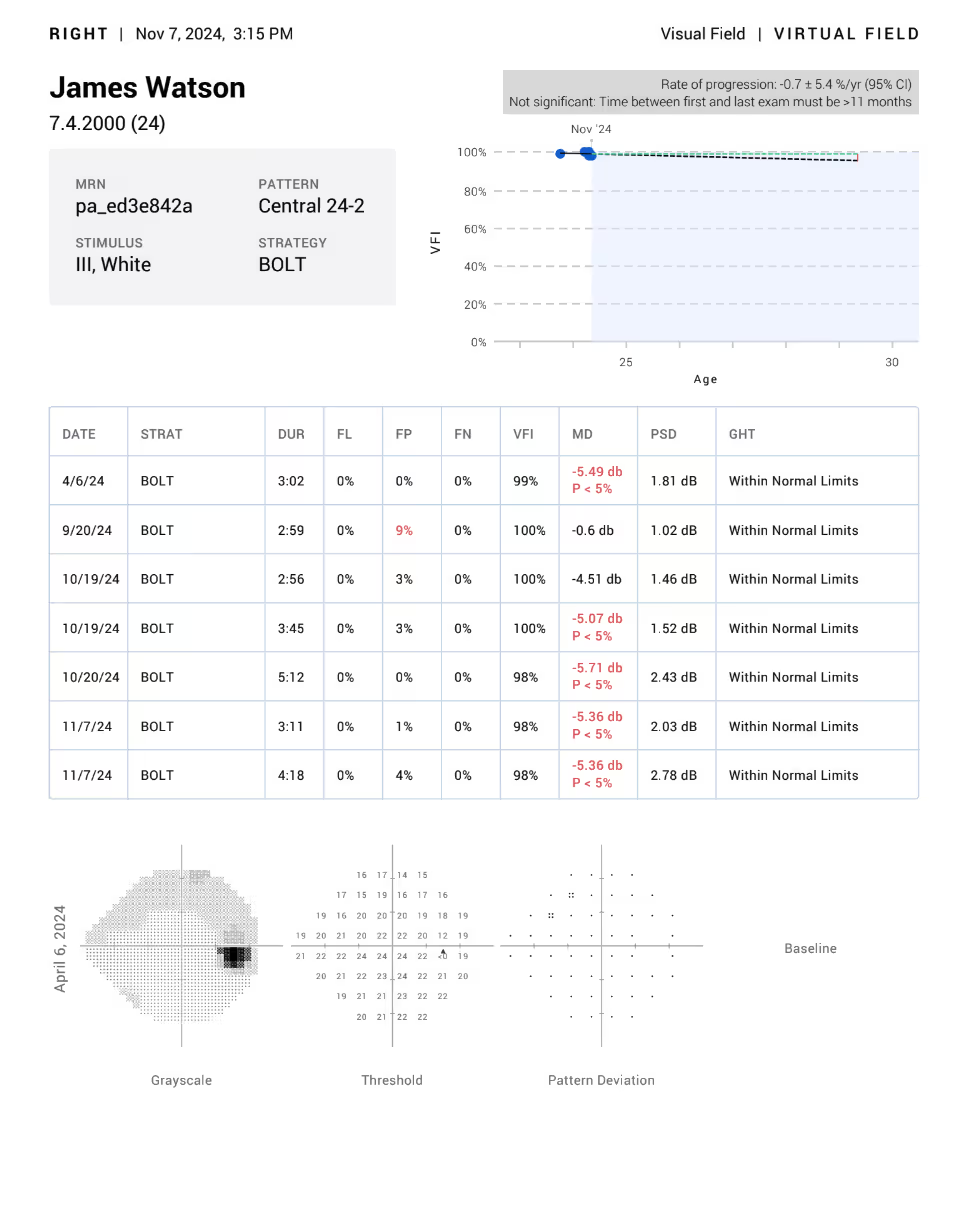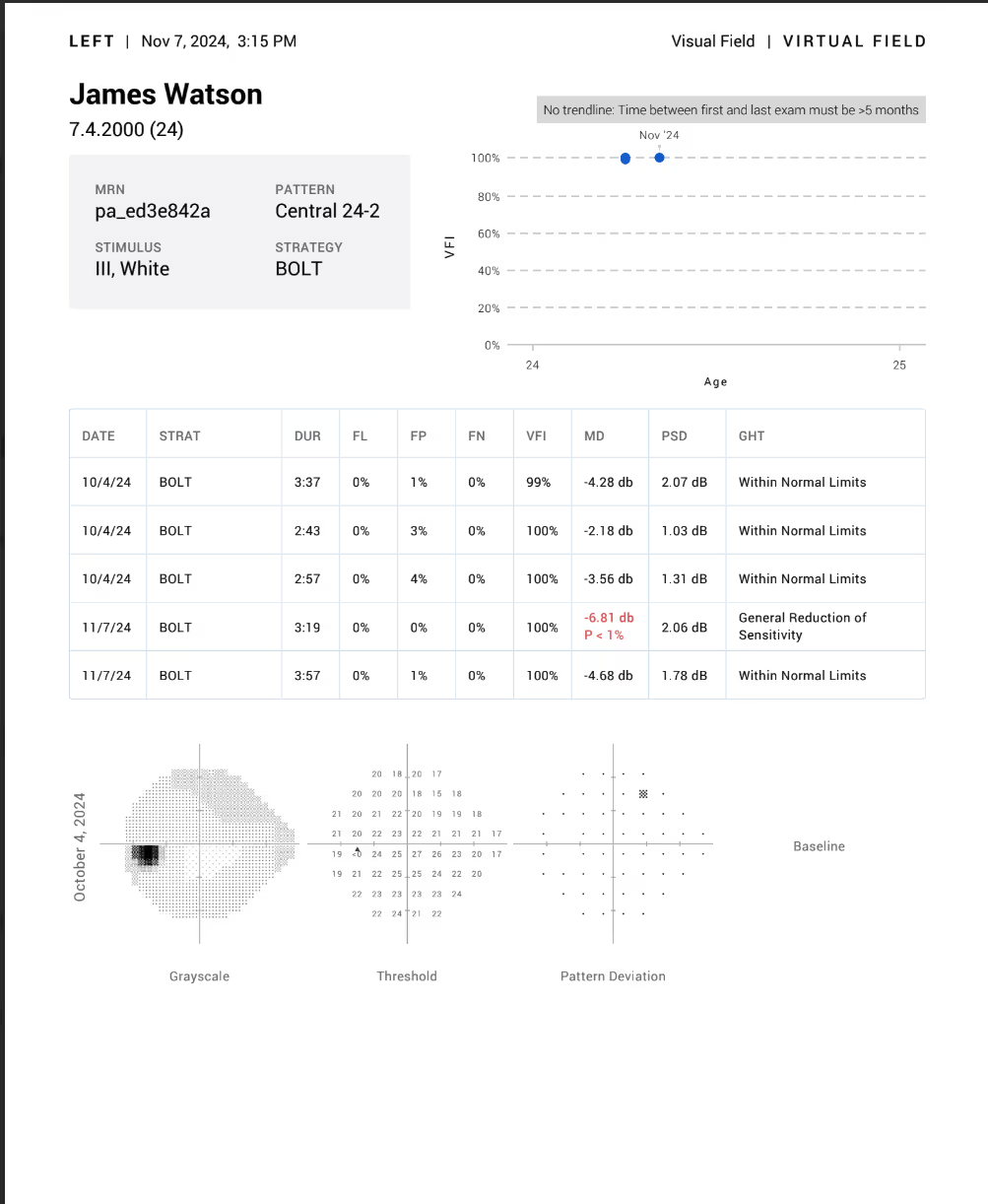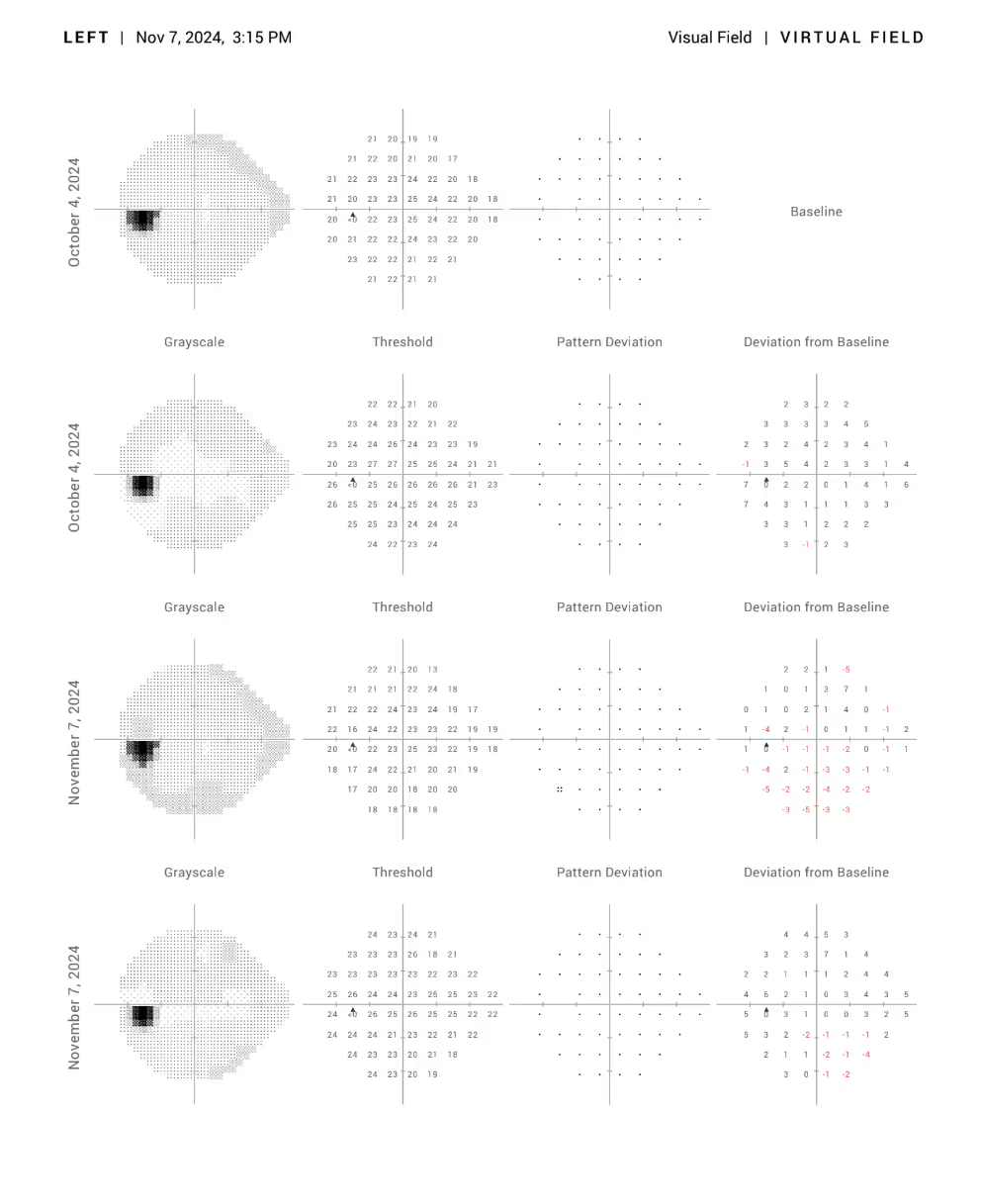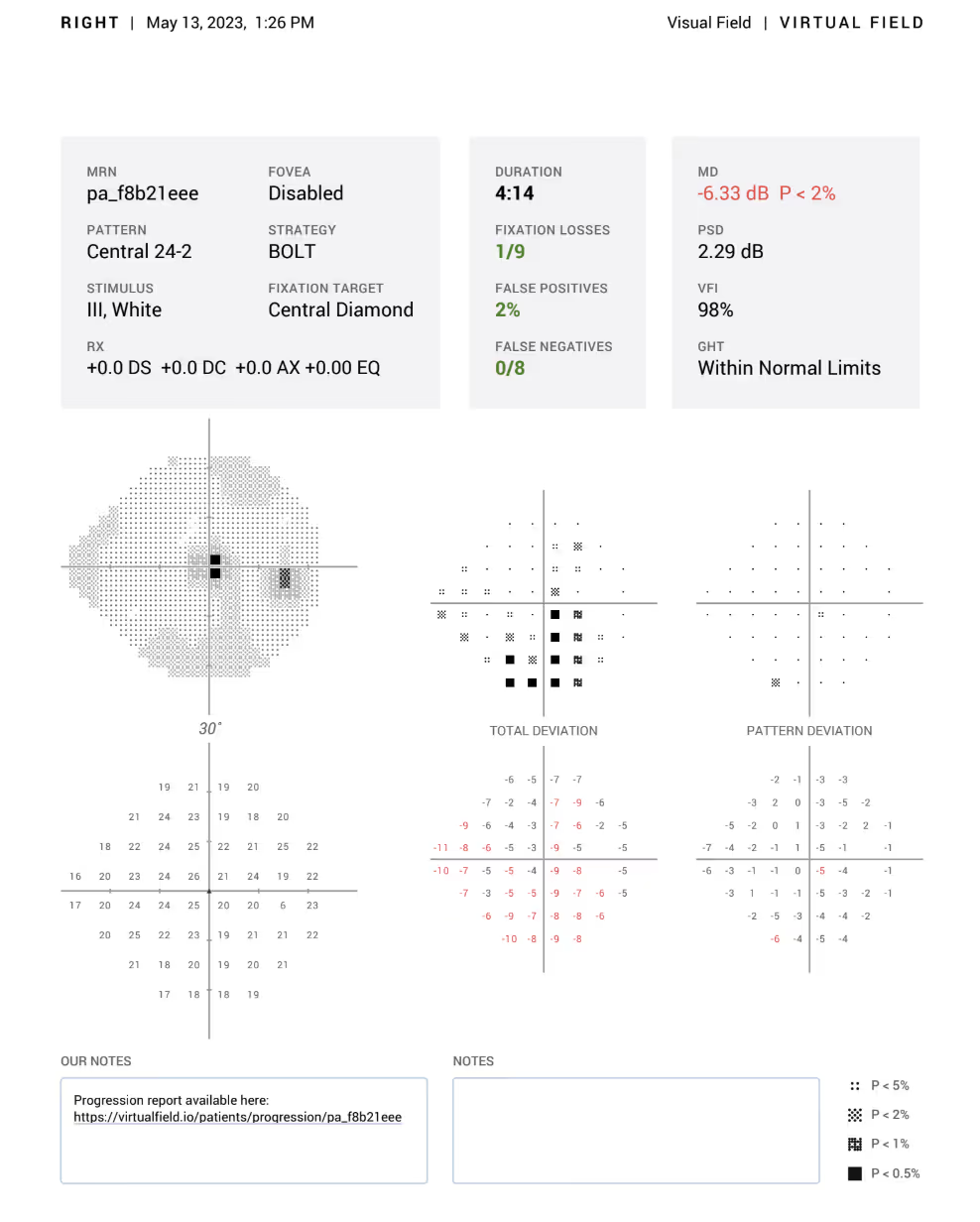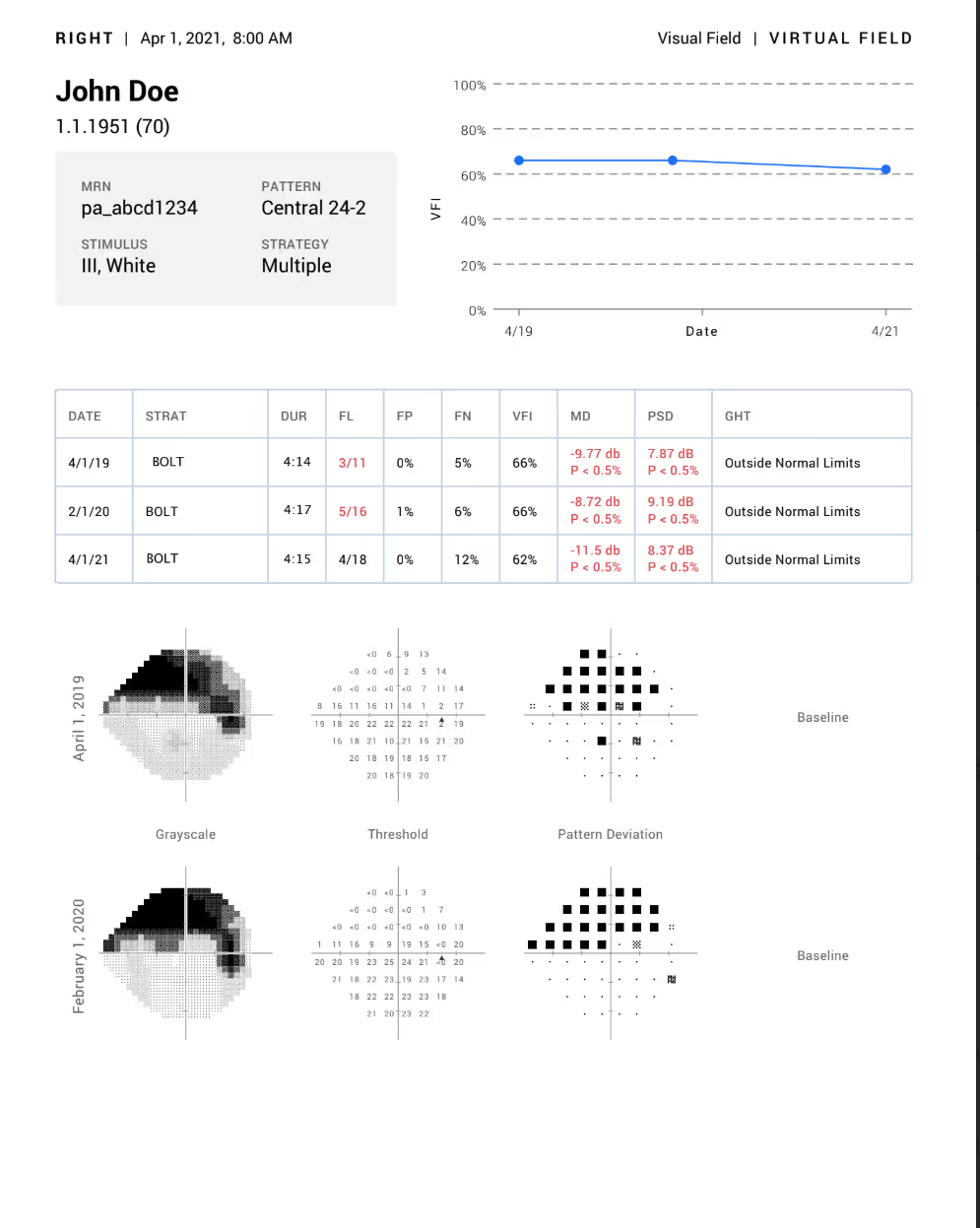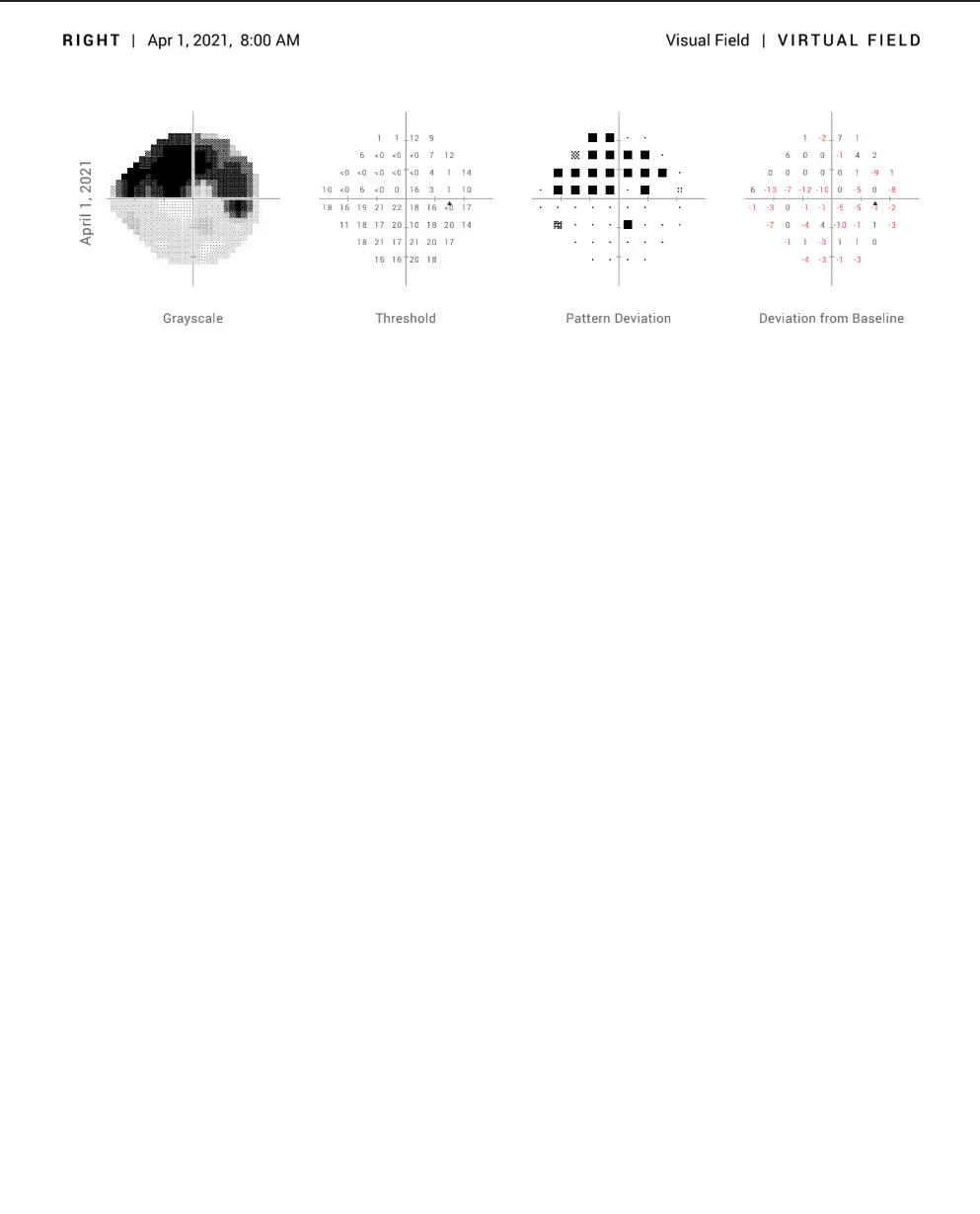Screening patients for glaucoma or neuro-ophthalmic disease still begins with the 24-2 visual field exam, but today’s clinicians also rely on the newer 24-2C visual field pattern for even more sensitivity in the central retina. This guide demystifies both tests and shows how head-mounted perimeter solutions such as Virtual Field deliver a more comfortable, accurate, and billable glaucoma progression test.
What Is the 24-2 Visual Field Exam?
The 24-2 visual field test divides the central 24° into 54 threshold points. A light stimulus dims or brightens until the patient detects it, mapping retinal sensitivity across the near-periphery.
• Primary use: Early-stage glaucoma progression test
• Secondary uses: Optic neuropathies, stroke, brain lesions, diabetic or hypertensive retinopathy, macular degeneration
It’s best-known as a glaucoma detection test that reliably identifies patterns like nasal steps and arcuate scotomas, but it can diagnose and monitor many more conditions.
Occasionally, you’ll see the 24-2 test called the HVF 24-2 or the Humphrey visual field exam. This name is a reference to the Humphrey visual field perimeter, which has been historically used to conduct this test since the 1980s. However, using a Humphrey Visual Field Analyzer to conduct this exam is not strictly necessary. Virtual Field is an innovative, streamlined, and patient-friendly alternative.
Key upgrade: Using a portable threshold perimeter such as Virtual Field slashes setup time, reduces patient fatigue, and produces “functionally indistinguishable” results compared with the Humphrey Field Analyzer (HFA).
Academic references and clinical validation
A prospective cohort study demonstrated that baseline central visual field loss measured with the 24-2 visual field testing strategy was predictive of more rapid and significant progression of global field damage in eyes with manifest glaucoma. This finding supports the clinical relevance and predictive value of the 24-2 exam in glaucoma management.
Research by Hood et al. (2022) compared the diagnostic accuracy of 24-2 and 10-2 perimetry tests. They found that the 24-2 test had better overall diagnostic accuracy, with a higher area under the ROC curve (0.808) compared to the 10-2 test (0.742). Results support the validity of the 24-2 exam by demonstrating its superior diagnostic accuracy compared to another commonly used test, reinforcing its effectiveness in clinical practice.
Recent research by Kahook and Noecker highlighted the importance of proper interpretation of the 24-2 Humphrey Visual Field printout, emphasizing factors such as pupil diameter and appropriate refraction that can influence test outcomes.
The 24-2 exam is the most common visual field test Virtual Field performs. In fact, Virtual Field users around the world conduct one of these exams every 12 seconds.

Clinical validation of Virtual Field’s 24-2 exam
One study compared the Virtual Field head-mounted perimeter to the Humphrey Field Analyzer in glaucoma and optic nerve disease patients. Researchers described the output as “functionally indistinguishable” to the Humphrey Visual Field Analyzer.
Another study compared virtual reality visual field testing to Humphrey visual field testing in an academic ophthalmology practice. The results showed that virtual visual field testing had similar accuracy to Humphrey virtual field testing but offered additional advantages like shorter test duration, fewer false positives, and lower costs.
In 2024, Virtual Field received the Medical Device Single Audit Program (MDSAP) certification, verifying that our leading eye exam experience meets rigorous international standards, including ISO 13485:2016 and the stringent U.S. Food and Drug Administration (FDA) requirements.
30 days free.
No strings attached.
We are confident you’ll love Virtual Field just like the 2,000 doctors who have already made the switch.
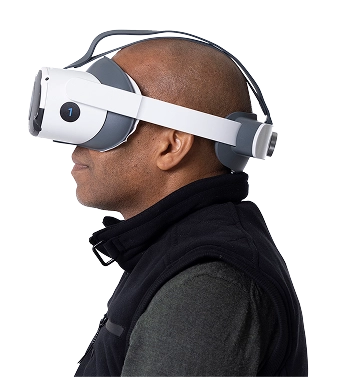
24-2 at a Glance — Pros, Cons, and Workflows
Ophthalmologists appreciate the 24-2 visual field exam for its ability to detect subtle, early visual field defects and monitor progression in conditions like glaucoma and optic neuropathies, providing reliable, repeatable results crucial for managing chronic diseases.
However, they often express frustration with the test's limitations on traditional tabletop devices, like the lengthy and fatiguing process, reliance on patient cooperation, and the need for expert interpretation of complex reports. Thankfully, Virtual Field addresses some pain points by improving patient comfort and streamlining workflows. For example, our DICOM 360 Sync transforms exam workflows into a fully connected, zero-touch experience — from patient setup to report sync to record attachment.
Workflow tip: The Virtual Field head-mounted perimeter also lets techs test either eye in under three minutes, freeing the exam lane for refractions or imaging.
Pros and cons of the 24-2 exam
We know the 24-2 exam is efficient, useful, and widely used, but there are pros and cons to incorporating this test into your routine.
Pros
This exam tests central and near-peripheral vision for a relatively comprehensive eye test.
You can identify subtle visual field defects, even before patients notice symptoms.
Objective and repeatable results with standardized data support accurate disease monitoring.
As a cornerstone exam, the 24-2 is available on most visual field testing devices.
The 24-2 is billable and reimbursable with patient insurance, including Medicare.
Cons
Without proper patient preparation, the 24-2 exam can feel long and stressful.
On traditional tabletop equipment, this exam can take several minutes per eye, which can impact clinic
Understanding reports and subtle changes in visual field requires expert interpretation.
It’s not a catch-all exam and more testing may be required to identify specific conditions.
Diseases and Disorders Detected With 24-2
Glaucoma
Glaucoma eye exams like the 24-2 monitor disease progression and assess the central visual field. Glaucoma can gradually affect peripheral vision, and the 24-2 test allows for early detection of functional changes in central and near-peripheral vision. It is often part of a comprehensive glaucoma workup for patients diagnosed with primary open-angle glaucoma, angle-closure glaucoma, or other related conditions.
Neurological disorders
The 24-2 exam can help reveal neurological conditions that affect the visual processing centers in the brain. Conditions like stroke, brain tumors, multiple sclerosis, and traumatic brain injury may change or damage the brain's visual pathways, which the 24-2 test can help detect.
Diabetic Retinopathy
Diabetic retinopathy is a leading cause of blindness in adults 11% of Americans have diabetes, and over a quarter of them will experience diabetic retinopathy. The 24-2 test can be used to detect early functional changes in the visual field, especially in the central region of vision that might not be detected by other diabetic eye exams.

11%
of Americans have diabetes 🇺🇸
+25%
over a quarter of them will experience diabetic retinopathy
Optic Neuropathy
Conditions like optic neuritis, optic neuropathy, or ischemic optic neuropathy can affect central vision. The 24-2 visual field exam is particularly useful in detecting and monitoring these conditions because it can identify visual field defects that may arise from optic nerve damage. This exam is crucial in tracking disease progression and assessing the impact of treatment in conditions that may compromise the optic nerve.
Macular Degeneration
Age-related macular degeneration and similar diseases usually affect the macula, but can also lead to peripheral visual field loss. The 24-2 test can detect these subtle changes, particularly in the early stages when functional changes may not be obvious on routine eye exams.
Hypertension
Chronic hypertension can cause damage to the retinal blood vessels, and over time, this can lead to visual field changes. The 24-2 exam can help detect early signs of peripheral or central vision loss related to hypertension and identify potential retinal damage or other related conditions like hypertensive optic neuropathy.
Other Conditions
The 24-2 exam can also be used to monitor or diagnose:
- Retinal vein/artery occlusion
- Retinal detachment
- Retinitis pigmentosa
- Autoimmune and inflammatory disorders
- Tumors and brain lesions
Example 24-2 Reports
30 days free.
No strings attached.
We are confident you’ll love Virtual Field just like the 2,000 doctors who have already made the switch.
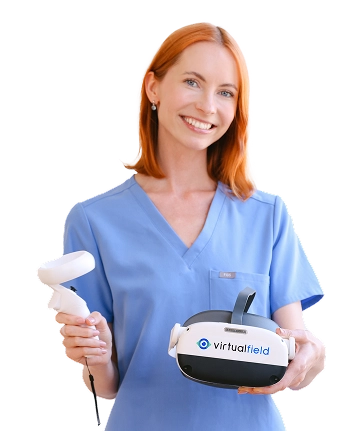
24-2C: Central-Enhanced Visual Field Testing
Introduced in 2019, the 24-2C visual field pattern adds 10 central points inside the 10° region—capturing early macular damage without the time penalty of running both 24-2 and 10-2.
Like its predecessor, the 24-2C divides the central 24 degrees of a patient’s vision into a grid to identify changes in the visual field. The 24-2C test includes the 54 points from the standard 24-2 test, plus 10 additional test points within the central 10 degrees of vision. The “C” refers to the increased sensitivity to detect central vision defects, which can point to glaucoma progression.
Before the introduction of this test, data with this level of detail required administering both the 24-2 and the 10-2 exam. Combining the two saves time, both for your workflow and your patients.
Academic references and clinical validation
The introduction of the 24-2C visual field test compares the 24-2 and 10-2 testing patterns, which traditionally were completed separately. Initial research shows that the 24-2C is comprehensive and can be treated as a hybrid test.
Another study compared the performance of the 24-2C and 10-2 test grids in patients with glaucoma and people suspected of having the condition. Both grids produced similar overall results, but the 10-2 detected more central visual field defects and showed better alignment with OCT scans. The 24-2C was faster, whereas the 10-2 provided more detailed insights.
One study evaluated the effectiveness of 24-2C, 24-2, and 10-2 visual field tests for detecting mild-stage glaucoma with central visual field defects. The 24-2C demonstrated superior detection accuracy, particularly in the upper-central visual field. It also significantly reduced test duration when compared to 24-2
and 10-2.
Conducting the 24-2C with Virtual Field
In 2024, Virtual Field added the 24-2C to our suite of visual field exams. This testing capability was automatically added to all Virtual Field devices, so there’s no extra cost or need to upgrade. Simply update your software to the latest version to begin offering the 24-2C.
Whether you choose the traditional 24-2 or newer 24-2C, the testing and billing processes are the same.
Billing and Coding (CPT 92083)
The 24-2 visual field exam is billable to insurance under CPT code 92083, which is designated for extended visual field exams.
• CPT 92083 – Extended visual field examination
• Typical Medicare Physician Fee Schedule (MPFS) reimbursement: $40–$90 (U.S.). Exact fees will, of course, depend on your location, setting, and payer-specific factors.
Cadence:
• Early glaucoma: Every 6–12 months
• Moderate–advanced: Every 3–6 months
• Systemic risk (DM, HTN, meds): As clinically indicated
When is the 24-2 exam required?
The 24-2 is a standard baseline exam for glaucoma patients. You can expect to re-examine people with early-stage glaucoma every six months to a year. For moderate to advanced glaucoma, cadence increases to every three to six months to monitor disease progression.
People often don’t notice changes to their visual field, so this exam is also ordered for patients with diabetes, hypertension, or a family history of eye disease. People taking certain medications known to increase intraocular pressure may also need the 24-2 exam to monitor visual changes.
Is the 24-2 visual field test required for driver’s licenses?
The 24-2 exam is more advanced than the basic field-of-vision checks required for driver’s licensing. Currently, this exam isn’t specifically mandated for drivers in the United States or Canada.
However, many states require a horizontal visual field of 120 degrees or better. In Canada, provinces have standards for visual acuity and peripheral vision, but don’t specify the 24-2 test.That said, if you incorporate the 24-2 into your routine exams, the detailed results can support the information necessary for driver’s licensing.
Start Conducting the 24-2 and 24-2c Exams with Virtual Field
The 24-2 visual field report is a wealth of diagnostic information when interpreted correctly. Diagnose, monitor, and manage a wide range of ocular and neurological conditions ranging from glaucoma to brain tumors.
Virtual Field makes 24-2 testing easier, more comfortable, and less stressful — both for patients and technicial.
All Virtual Field devices now ship with 24-2C unlocked and our device is MDSAP & ISO 13485 certified, meeting FDA QSR standards.
Want all 23 exam guides in one place?
Download our comprehensive guide for 160+ pages of insights.
FAQs
1. What’s the practical difference between 24-2 and 24-2C?
2. Does 24-2C cost more to bill than 24-2?
3. How often should moderate-risk glaucoma patients repeat a 24-2 test?
4. Can I run mixed 24-2/24-2C sessions back-to-back?
5. Does 24-2C require a larger pupil size?
6. How does Virtual Field flag progression across 24-2 series?
7. Why does 24-2C pick up central glaucoma loss better than a standard 24-2?
8. Does cataract surgery affect 24-2/24-2C mean deviation results?
9. How do I set up fast test–retest for suspicious 24-2C defects?
10. What reliability indices should I watch on 24-2C before trusting the printout?
Ready to get started?
Schedule a demo or begin your 30-day free trial of Virtual Field to try the 24-2 exam in your practice.
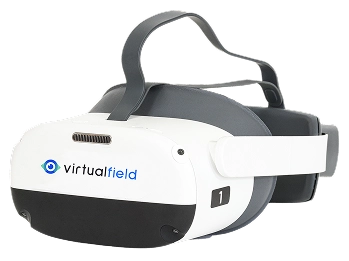
Questions? Contact sales@virtualfield.io talk to a Virtual Field expert today.

